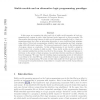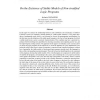JAIR
2012
12 years 7 months ago
2012
Circumscription and logic programs under the stable model semantics are two wellknown nonmonotonic formalisms. The former has served as a basis of classical logic based action for...
LPNMR
2011
Springer
13 years 7 months ago
2011
Springer
We present an approach to integrating rules and ontologies on the basis of the first-order stable model semantics defined by Ferraris, Lee and Lifschitz. We show that a few exist...
AMAI
1999
Springer
14 years 4 months ago
1999
Springer
Logic programming with the stable model semantics is put forward as a novel constraint programming paradigm. This paradigm is interesting because it bring advantages of logic prog...
CORR
1998
Springer
14 years 4 months ago
1998
Springer
In this paper we reexamine the place and role of stable model semantics in logic programming and contrast it with a least Herbrand model approach to Horn programs. We demonstrate ...
AI
1998
Springer
14 years 4 months ago
1998
Springer
We argue that the situation calculus is a natural formalism for representing and reasoning about control and strategic information. As a case study, in this paper we provide a sit...
CORR
2004
Springer
14 years 4 months ago
2004
Springer
In this paper we analyze the relationship between cyclic definitions and consistency in GelfondLifschitz's answer sets semantics (initially defined as `stable model semantics...
NMELP
1994
14 years 8 months ago
1994
In Prz91], Przymusinski introduced the partial (or 3-valued) stable model semantics which extends the (2-valued) stable model semantics dened originally by Gelfond and Lifschitz G...
ASP
2001
Springer
14 years 9 months ago
2001
Springer
Default Logic and Logic Programming with stable model semantics are recognized as powerful frameworks for incomplete information representation. Their expressive power are suitabl...
LPNMR
2009
Springer
14 years 9 months ago
2009
Springer
Several proposals of the semantics of aggregates are based on different extensions of the stable model semantics, which makes it difficult to compare them. In this note, building ...
LPNMR
2004
Springer
14 years 10 months ago
2004
Springer
Over recent years, various semantics have been proposed for dealing with updates in the setting of logic programs. The availability of different semantics naturally raises the que...




